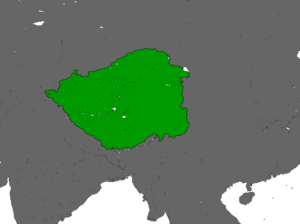
Back سلالة فاغمودروبا Arabic ফাগ-মো-গ্রু-পা রাজবংশ Bengali/Bangla ཕག་གྲུའི་སྲིད་སྐྱོང་དུས་རབས། Tibetan Phagmodrupa-Dynastie German Dinastía Phagmodrupa Spanish Période Phagmodrupa French Dinastia Phagmodrupa Italian パクモドゥパ政権 Japanese Phagmodų dinastija Lithuanian Phagmodru-dynastie Dutch
Phagmodrupa dynasty ཕག་མོ་གྲུ་པ་ 帕木竹巴 | |||||||||
|---|---|---|---|---|---|---|---|---|---|
| 1354–1618 | |||||||||
 The Phagmodrupa dynasty in 1354 | |||||||||
| Capital | Nêdong | ||||||||
| Common languages | Tibetan | ||||||||
| Religion | Tibetan Buddhism | ||||||||
| Government | Buddhist theocracy | ||||||||
| Monarch | |||||||||
• 1354-1364 | Tai Situ Changchub Gyaltsen (first) | ||||||||
• c.1600-1618 | Mipham Sonam Wangchuk Drakpa Namgyal Palzang (last) | ||||||||
| History | |||||||||
• Established | 1354 | ||||||||
• Disestablished | 1618 | ||||||||
| |||||||||
| Today part of | China | ||||||||
| History of Tibet |
|---|
 |
| See also |
|
|
The Phagmodrupa dynasty or Pagmodru (Tibetan: ཕག་མོ་གྲུ་པ་, Wylie: phag mo gru pa, IPA: [pʰʌ́kmoʈʰupa]; Chinese: 帕木竹巴) was a dynastic regime that held sway over Tibet or parts thereof from 1354 to the early 17th century. It was established by Tai Situ Changchub Gyaltsen of the Lang (Wylie: rlangs) family at the end of the Yuan dynasty. The dynasty had a lasting importance on the history of Tibet; it created an autonomous kingdom after Yuan rule, revitalized the national culture, and brought about a new legislation that survived until the 1950s. Nevertheless, the Phagmodrupa had a turbulent history due to internal family feuding and the strong localism among noble lineages and fiefs. Its power receded after 1435 and was reduced to Ü (East Central Tibet) in the 16th century due to the rise of the ministerial family of the Rinpungpa. It was defeated by the rival Tsangpa dynasty in 1613 and 1620, and was formally superseded by the Ganden Phodrang regime founded by the 5th Dalai Lama in 1642. In that year, Güshi Khan of the Khoshut formally transferred the old possessions of Sakya, Rinpung and Phagmodrupa to the "Great Fifth".[1]
- ^ Zahiruddin Ahmad, Sino-Tibetan relations in the seventeenth century. Rome 1970, p. 102.
